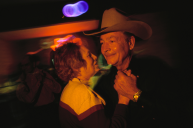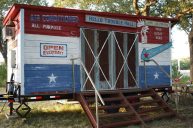[dropcap]I[/dropcap]f you're ever near Blanco, Texas on the first Saturday evening of the month, you can head down US-281 and veture back in time. Six miles south of Blanco, tucked away in the Hill Country woods, stands the 147-year-old Twin Sisters Dance Hall, one of the oldest Texas dance halls in existence. Inside, couples in boots and pearl snap shirts spin around on the well-worn dance floor to live Texas dance hall music.
Videos by Wide Open Country
In Texas, historic dance halls like Twin Sisters aren't hard to find. But the truth is, they're fewer and farther between than they were a few decades ago. Of the 1,000 Texas dance halls that were built in the 19th and 20th century, less than 400 remain standing. Even less are in use. Many dance halls struggle to stay afloat while others sit abandoned in fields and on private property. And that's a shame. Texas dance halls are more than just a place for dancing (although they're wonderful for doing just that). They're an integral part of Texas communities, used for fundraisers, weddings and reunions - all of which revolve around music and dancing. Thankfully, a group of devoted Texans are working to save an iconic part of Lone Star State history.
One Two-Step at a Time
Jo Nell Haas has been involved with Twin Sisters Dance Hall for over 20 years and was voted president of the hall four years ago. Haas said the majority of historic dance halls are maintained through grassroots community fundraising. The Blanco community is currently raising money for a new roof, which will cost about $75,000. To raise the money, Twin Sisters is holding a "Raise the Roof" fundraiser on Sept. 23. When you're in the dance hall business, chili cook offs and country dances are how you get things done.
Haas says keeping the buildings historically accurate poses a challenge.
"You're working with the Texas Historical Commission. You're trying to do it and keep it as historically accurate as possible and that's a very expensive way to do things," Haas tells Wide Open Country. "You can't just slap a roof up on there. You have to make sure you maintain the quality and integrity of the historical value of that building."
But for everything the community puts into the dance hall, Twin Sisters gives back twofold. The hall is used for countless community events. Recently, the Blanco senior prom was held at Twin Sisters, where students danced the night away in the old building. The dance hall even received national exposure when CMA nominee Jon Pardi filmed the video for "Head Over Boots" at Twin Sisters.
Deb Fleming, the executive director of Texas Dance Hall Preservation, Inc., says it's important to get younger generations excited about dance halls.
"The people that maintain a lot of these community halls are people that were born and raised there and stayed there and are aging out," Fleming explains.
Texas Dance Hall Preservation serves as a resource for dance halls across the state, connecting them with contractors and assisting with marketing. This fall, the group will team up with Asleep at the Wheel for the Texas Dance Hall Tour, a trip through some of Texas' most historic halls.
Rules of the Hall
So what separates a dance hall from a honky tonk? Fleming says in order to officially quality as a historic dance hall, the building should be over 50 years old and have one very important element: a large dance floor. In fact, the dance floor should be the main architectural feature of the building.
"It's different than a honky tonk (which is) more of a bar setting," Fleming notes. "There may be a dance floor but it's a small dance floor tucked over here in the corner in front of the stage."
Fleming says dance hall regulars take dancing seriously. Camping out on the floor with your beer while Instagramming your new boots is seriously frowned upon.
"Dance halls are meant to be danced in. A lot of halls don't want people standing on their dance floor. They want people dancing on their dance floor," Fleming says. "So we're trying to get the bands to realize that if you want to play dance halls you have to educate your fans that these places are to be danced in and to be honored in that kind of way."
If you're planning your own Texas dance hall tour, you'll need to plan ahead. Dance halls like Gruene Hall that have public performances nearly every night are kind of an anomaly. Most have dances once a month, at most. And the out-of-the-way dance halls are the ones that need the most support, Haas says.
"Those of us who are destination dance halls - it's a whole different ball game keeping it open," Haas says. "You have to plan it, you've got to be able to drive to it and you have to have room and board if you're not real close."
https://www.instagram.com/p/BRYYxc8DOn1/?tagged=kendaliahalle
A Texas Tradition
Wesley Holtsford, a professional fiddle player who's played nearly every Texas dance hall from San Antonio to Schulenburg, connected with Texas dance hall music from an early age.
"It's beautiful music - sometimes happy, sometimes heart-wrenching, paired with a toe-tapping beat, twin fiddles and steel guitar," Holtsford explains. "Compare Ray Price and Bob Wills at certain points in their career. They are the embodiment of what becomes our 'dance hall music.' It's a different sound from the Grand Ole Opry and the Louisiana Hayride."
According to Holtsford, dance halls are unique to Texas and something that should be preserved for future generations.
"It was a central meeting place for families and their communities in the early days. It used to be more than just going to a bar," Holtsford notes. "Entertainment is so readily available, it's no wonder people don't go out or can't dance. To me, it's important to keep this tradition alive because there's something in it culturally that belongs to Texas alone."
Haas says she's seen people return to dance halls to find a connection to community and family history.
"It's keeping our heritage alive. We have many, many people come back who've said 'I grew up here as a little kid' or 'I have a picture of my grandparents with their wedding anniversary here.' It seems like people are looking for those roots," Haas says. "They're looking for that connection that they lost for a while."
If you want to keep this important Texas tradition alive, the best way to help save Texas dance halls is just to go to one. Bring a friend (or five). Take in the music and get out on the dance floor.
"If you don't go out and experience that you're really missing out on a lot," Fleming says. "Don't be afraid to venture out and find a dance hall off the beaten path."
For more information on Texas dance halls, visit the Texas Dance Hall Preservation Facebook page.




